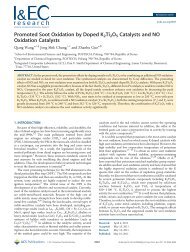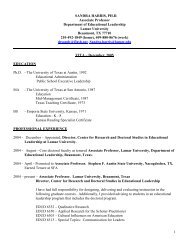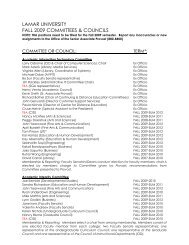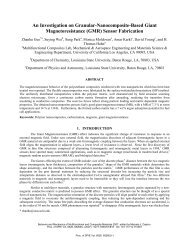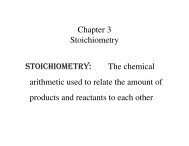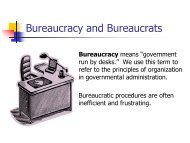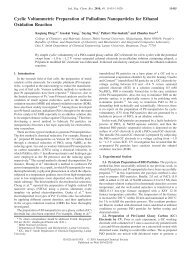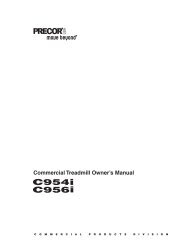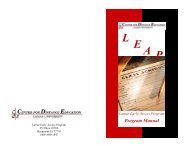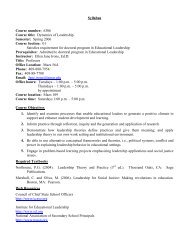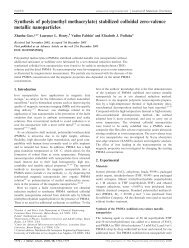Removal of Heavy Metals from Wastewater Using Crab shells
Removal of Heavy Metals from Wastewater Using Crab shells
Removal of Heavy Metals from Wastewater Using Crab shells
You also want an ePaper? Increase the reach of your titles
YUMPU automatically turns print PDFs into web optimized ePapers that Google loves.
<strong>Removal</strong> <strong>of</strong> <strong>Heavy</strong> <strong>Metals</strong><br />
<strong>from</strong> <strong>Wastewater</strong><br />
<strong>Using</strong> <strong>Crab</strong> <strong>shells</strong><br />
By<br />
Kenneth Dorris
Water Pollution<br />
Some Sources <strong>of</strong> water pollution Include<br />
1. Agricultural waste - Nutrients contribute<br />
to water pollution by stimulating<br />
excessive growth <strong>of</strong> aquatic plants.<br />
2. Sewage<br />
3. Industrial wastes - which include heavy<br />
metals such as Pb, Hg, Cd, Ni, & others
Various technologies have been developed<br />
to remove toxic metal ions <strong>from</strong> water<br />
1. Filtration<br />
2. Chemical precipitation<br />
3. Adsorption<br />
4. Ion exchange<br />
5. Electrodeposition, and<br />
6. Membrane systems.
All <strong>of</strong> these technologies have<br />
advantages and limitations<br />
• They are either low cost but not very<br />
effective - <br />
• Or effective and can be expensive –
The Modern Thinking in the area <strong>of</strong><br />
Waste Treatment is Increasingly in the<br />
area <strong>of</strong> SYMBIOTIC RELATIONS<br />
The Use <strong>of</strong> WASTE<br />
<strong>of</strong> one Industry by Another<br />
Which in Turn<br />
BENEFITS BOTH
Some Waste Material Might Include<br />
1. Sea Food Industry<br />
- - e.g., <strong>Crab</strong> Shells<br />
2. Lumber / Timber /<br />
Paper Industry<br />
- - e.g., Sawdust<br />
3. Agricultural waste<br />
producing excessive<br />
plant growth<br />
- - e.g., Water Hyacinth,<br />
duckweed, etc which<br />
inhibit navigation
<strong>Crab</strong> <strong>shells</strong> were used to remove heavy<br />
metals in aqueous solutions.<br />
Advantages <strong>of</strong> crab shell waste include<br />
1. availability<br />
2. low cost and<br />
3. high biocompatibility
<strong>Crab</strong> shell waste is an abundant<br />
source <strong>of</strong> chitin<br />
Chitin<br />
[poly-β-(1,4)-N-acetyl-D glucosamine]<br />
Is a Cellulose-like Biopolymer
When chitin is treated with<br />
concentrated alkali, it undergoes<br />
various degrees <strong>of</strong> deacetylation<br />
and degradation, to give a<br />
product called chitosan<br />
Chitosan is the most important<br />
derivative <strong>of</strong> chitin
H NHCOCH 3<br />
O<br />
OH H H H<br />
H O O<br />
CH 2 OH<br />
CH 2 OH<br />
O O<br />
OH<br />
H<br />
H NHCOCH 3<br />
H<br />
H NHCOCH 3<br />
OH H<br />
O O<br />
CH 2 OH<br />
Chitin<br />
H NH 2<br />
O<br />
OH H H H<br />
H O O<br />
CH 2 OH<br />
CH 2 OH<br />
O<br />
OH<br />
H NH 2<br />
H<br />
O<br />
H<br />
H NH 2<br />
OH H<br />
O<br />
CH 2 OH<br />
O<br />
Chitosan<br />
O<br />
H<br />
OH<br />
OH<br />
H H H<br />
H O O<br />
CH 2 OH<br />
CH 2 OH<br />
O<br />
OH<br />
H OH<br />
H<br />
O<br />
H<br />
H OH<br />
OH H<br />
O<br />
CH 2 OH<br />
O<br />
Cellulose<br />
Figure 1.1 Chemical Structure <strong>of</strong> Chitin, Chitosan and Cellulose.<br />
Source: Lin, Shan-Yang; Perng, R. Chem. Pharm. Bull. 1992, 40,<br />
1058-1060
<strong>Crab</strong> shell Waste<br />
Soaked in 5% HCl for 1 hr (R.T.)<br />
Soaked in 50% NaOH for 1 hr (90 o C)<br />
Rinsed with water and Air Dried<br />
Adsorbent ≡ Treated <strong>Crab</strong> <strong>shells</strong>
Instruments & Chemicals<br />
• Varian 220 A A Spectrometer<br />
• Fisher Scientific pH-meter<br />
• Precision Scientific Corporation Shaker<br />
• Reference Solutions for AA measurements<br />
obtained <strong>from</strong> Fisher Scientific<br />
• All chemicals were ACS reagent grade
Experimental<br />
Initial concentrations <strong>of</strong> metal ions were<br />
2.5 mg/L, 5 mg/L, 7.5 mg/L, and 10 mg/L<br />
<strong>Crab</strong> shell quantities were<br />
10 g/L, 25 g/L, and 50 g/L
Typical Experimental Procedure<br />
1. Adsorbent + 100 mL metal ion solution<br />
2. Agitated at 80 rev/min at room temp.<br />
3. Samples taken at 5, 20, 60, 180 & 360 min<br />
4. Analysis by Atomic Absorption
Effect <strong>of</strong> <strong>Crab</strong> Shell Loading (10g/L) on<br />
Adsorption with 2.5 mg/L Lead<br />
Time<br />
(min)<br />
Lead<br />
mg/L<br />
0 0.00<br />
5 2.38<br />
20 2.37<br />
60 2.46<br />
180 2.43<br />
360 2.45
Adsorption <strong>of</strong> Lead vs Time (mins)<br />
3<br />
Adsorption <strong>of</strong> Lead<br />
2.5<br />
2<br />
1.5<br />
1<br />
0.5<br />
0<br />
0 200 400 600 800 1000 1200 1400
Chitosan interacts efficiently<br />
with transition metal ions
Protonation<br />
CH 2 OH<br />
O<br />
OH<br />
N<br />
H H<br />
Chelation<br />
CH 2 OH<br />
O<br />
OH<br />
O<br />
O<br />
+ H + +<br />
+ 1/nM n+ NO 3<br />
-<br />
CH 2 OH<br />
O O<br />
OH<br />
H<br />
H<br />
H - NO3<br />
N +<br />
CH 2 OH<br />
O O<br />
+ 2H +<br />
+<br />
NO 3<br />
-<br />
H<br />
H<br />
H - NO3<br />
N +<br />
O<br />
N<br />
M/n<br />
H<br />
H<br />
+)<br />
Total reaction<br />
CH 2 OH<br />
O<br />
OH<br />
CH 2 OH<br />
O<br />
O<br />
+ 1/nM n+<br />
O<br />
+ H +<br />
N<br />
H H<br />
O<br />
NH 2<br />
M/n
Chelation Ion Exchange<br />
As opposed to simple ion exchange,<br />
chelation ion exchange takes advantage<br />
<strong>of</strong> the three dimensional structure <strong>of</strong><br />
molecules to chelate and remove ions <strong>of</strong><br />
a specific size in the presence <strong>of</strong> large<br />
quantities <strong>of</strong> other ions.
Adsorption Kinetics influenced by<br />
• Initial metal ion concentration,<br />
• amount <strong>of</strong> adsorbent,<br />
• pH value <strong>of</strong> solution and<br />
• temperature
Effect <strong>of</strong> Initial Metal Ion Concentration<br />
The initial metal ion concentration was<br />
one <strong>of</strong> the most important factors that<br />
determined the equilibrium<br />
concentration, but also determines the<br />
uptake rate <strong>of</strong> metal ion
Effect <strong>of</strong> pH on Adsorption<br />
Adsorption <strong>of</strong> metal ions increased with<br />
increases in pH. For lead, the sharpest<br />
increase was obtained between pH 1 and 4,<br />
while around pH 6 a plateau was reached,<br />
and above pH 6, adsorption almost<br />
remained constant. Experiments were<br />
carried out in pH range <strong>of</strong> 7-8
3<br />
2.5<br />
2<br />
1.5<br />
1<br />
0.5<br />
0<br />
Effect <strong>of</strong> pH on Adsorption<br />
Cadmium<br />
Lead<br />
Nickel<br />
0 2 4 6 8 10<br />
pH Value<br />
Adsorption <strong>of</strong> Lead, Cadmium<br />
and Nickel
Percent(%)<br />
120<br />
100<br />
Percent Adsorption vs pH<br />
Concentration <strong>of</strong> Pb, Cd and Ni 2.5 mg/L<br />
<strong>Crab</strong> Shell: 10 g/L<br />
80<br />
60<br />
40<br />
Cadmium<br />
Lead<br />
Nickel<br />
20<br />
0<br />
1 2 3 4 5 6 7 8 9
Effect <strong>of</strong> <strong>Crab</strong> Shell Loading (10g/L) on Adsorption<br />
with 2.5 mg/L Lead and 1000 ppm Anion Solution<br />
Time<br />
min<br />
Cl - Br - F - CH 3<br />
CO<br />
O - SO 4<br />
2-<br />
NO 3<br />
-<br />
PO 4<br />
-<br />
0 0.0 0.00 0.00 0.00 0.00 0.0 0.0<br />
5 1.99 2.07 2.15 2.15 2.01 2.02 2.37<br />
20 2.04 2.23 2.32 2.28 2.30 2.28 2.36<br />
60 1.86 2.09 2.12 2.31 2.07 2.40 2.42<br />
180 2.30 2.30 2.41 2.41 2.37 2.33 2.42<br />
360 2.27 2.35 2.39 2.45 2.38 2.44 2.19
Effect <strong>of</strong> Anions on Adsorption<br />
3<br />
Adsorption <strong>of</strong> Lead<br />
2.5<br />
2<br />
1.5<br />
1<br />
0.5<br />
Chloride<br />
Bromide<br />
Fluoride<br />
Acetate<br />
Sulfate<br />
Nitrate<br />
Phosphate<br />
0<br />
0 50 100 150 200 250 300 350 400<br />
Time(min)
Regeneration <strong>of</strong> <strong>Crab</strong> <strong>shells</strong><br />
<strong>Crab</strong> shell samples which had<br />
been exposed to heavy metal<br />
solutions and adsorbed up to<br />
97 percent lead, cadmium and<br />
nickel were stripped with 0.1<br />
M HNO 3<br />
(pH~1.3). The heavy<br />
metal cations were almost<br />
completely removed <strong>from</strong> the<br />
crab <strong>shells</strong>.
In Conclusion<br />
• Advantages <strong>of</strong> the chitosan in parially<br />
converted crab shell waste include<br />
<br />
• The Observed Results indicated that the<br />
metal uptake process was successful based<br />
on the ion exchange chelation mechanism
In Conclusion<br />
• pH values influence the adsorption<br />
• No effect <strong>of</strong> anions on crab <strong>shells</strong> was<br />
observed<br />
• On changing <strong>Crab</strong> Shell Quantity and metal<br />
ion concentration, the uptake rate changes



